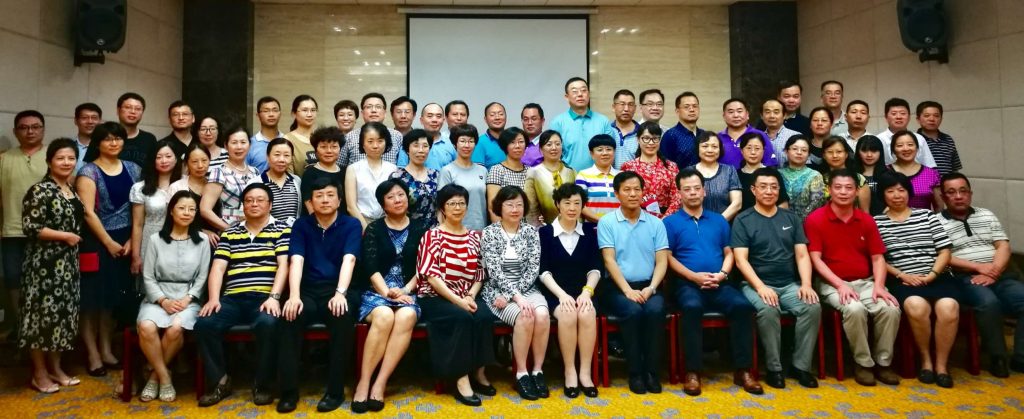
The Members of the Group of Emergency and Critical Care Medicine affiliated to Chinese Pediatric Society in 2017
by Dr Suyun Qian
The early 1980s saw the development of pediatric intensive care unit (PICU) in mainland China, and we have witnessed tremendous advances in the past 30 years. As a relatively new medical specialty, Pediatric Intensive Care Medicine has shown rapid advances in PICU quantity, qualities, capacity, facility, technology and staffing.
The early stage of Pediatric Intensive Care Medicine in China
The establishment and development of Chinese PICU benefit from the United Nations International Children’s Emergency Fund (UNICEF) project. During the period from 1982 to 1984, the National Health and Family Planning Commission of the People’s Republic of China (Ministry of Health) and UNICEF joined effort in the establishment of the “Pediatric Intensive Care Training Project”. The project chose 11 Chinese hospitals, including four key hospitals (Beijing Children’s Hospital of Capital Medical University, Shengjing Hospital of China Medical University, Children’s Hospital of Chongqing Medical University, and Shanghai Children’s Hospital). In 1983, with the support of World Health Organization (WHO), Professor Fan Xunmei of Beijing Children’s Hospital, who was acknowledged as the pioneer and founder of Chinese pediatric critical care medicine, set up the first PICU (equipped with only 1 ventilator and 6 beds) in mainland China. Based on “Pediatric Intensive Care Training Project”, ICUs or emergency care centers, including pediatric intensive care unit (PICU), neonatal intensive care unit (NICU), and surgical intensive care unit (SICU), were set up in the hospitals mentioned above. This laid the foundation for the development of Chinese pediatric intensive care medicine.
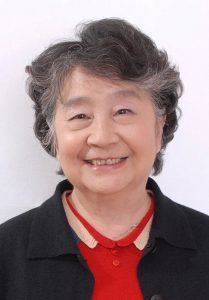
Prof. XunMei Fan
Development of the Chinese Pediatric Intensive Care Medicine and Establishment of Academic Organizations
From the end of 1980s to 1990s, many Chinese children’s hospitals and even pediatric departments of general hospitals have set up ICU. In the late 1980s, master degree candidates (major in pediatric critical care medicine) were enrolled; in 1990s, doctoral degree candidates were enrolled in Beijing, Shanghai, Chongqing, Shenyang and other cities in China; in addition, many young doctors and nurses were selected to go abroad for further training. These training programs have produced many senior pediatricians, who have become the mainstay of pediatric intensive care medicine in China.
With the development of pediatric intensive care medicine, academic organizations are expected to establish and promote academic exchanges. In 1988, the Sub-specialty Group of Pediatrics affiliated to Chinese Society of Emergency Medicine of Chinese Medical Association was established. Professor Zhao Xiangwen served as head of the group, and Professor Fan Xunmei as the deputy head. In 1993, the Group of Emergency Medicine affiliated to Chinese Pediatric Society of Chinese Medical Association was established and led by Professor Zhao Xiangwen and Professor Fan Xunmei.
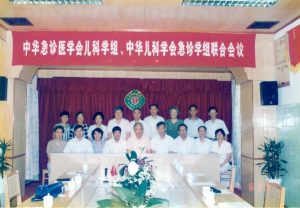
Emergency Medicine established 1993
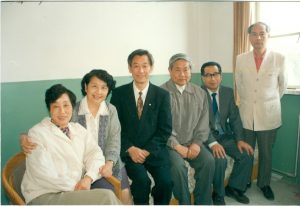
Former members of the Group of Emergency and Critical Care Medicine in 1993,from left to right: LinNen Zhang, Prof. XunMei Fan, Prof. ZhongQi Dong, Prof. XiangWen Zhao, Prof. HaoFu Hu, Prof. QingZhong He
Major Achievement of Our Academic Society
Our academic society is the combination of two academic organizations (the Subspecialty Group of Pediatric and the Group of Emergency Medicine). Every two year, from 1989, our society has held the National Conference on Pediatric Critical Illness (NCPCI). Over the past 20 years, our academic society has organized 14 national conferences and many symposia on pediatric critical illness. We have made a positive contribution to the development of guideling and the promotion of the Chinese pediatric intensive care medicine.
In recent 10 years, with the rapid development of the national economy and the outbreak of public health emergencies such as hand-foot-and-mouth disease, Chinese pediatric critical care society has entered a period of rapid development. In China, the number of doctors and nurses engaging in pediatric intensive care medicine has been steadily increasing. The number of PICU in China has increased significantly, and the PICU capacity has gradually expanded. In order to standardize the diagnosis and treatment protocols of pediatric critical diseases and improve the treatment skills of care staff, our academic society has dedicated itself to providing clinical guidelines, in line with the development of PICU in local hospital throughout China. The list of details is as follows:
- Pediatric Critical Illness Score (primary edition)
- Recommended protocol for diagnosis and treatment of septic shock in children. Chin J Pediatr.2006 Aug; 44(8):596-598.
- Experts’ consensus on sedation and analgesia in pediatric intensive care unit (2013). Chin J Pediatr. 2014 Mar; 52(3):189-193.
- Criteria and practical guidance for determination of brain death in children (BQCC version). Chinese Medical Journal.2014, 5(23):4140-4144.
- Expert consensus for the diagnosis and management of septic shock (infectious shock) in children (2015). Chin J Pediatr. 2015 Aug; 53(8):576-580.
- Expert consensus on clinical application of noninvasive continuous positive airway pressure in children. Chin J Pediatr. 2016 Sep; 54(9):649-652.
- Expert’s consensus on clinical application of bi-level positive airway pressure ventilation in children. Chin J Pediatr. 2017 May 4;55(5):324-328.
- Training programs: our academic society has carried out some training programs, mainly in “pediatric advanced life support (PALS)”, “pediatric mechanical ventilation “and “continuous blood purification treatment”.
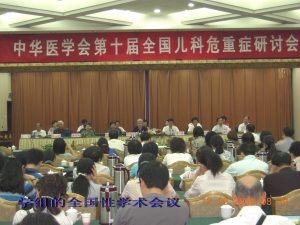
10th National Conference in Pediatric Critical illness in 2008
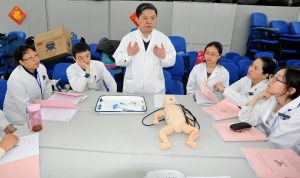
PALS training in China
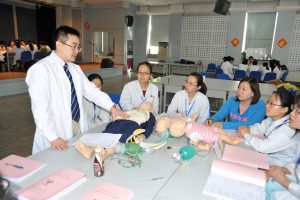
PALS training in China
The Role of PICU in Preparing for and Responding to Public Health Emergencies
PICU plays an increasing important role in dealing with public health emergencies. The outbreak of SARS in 2003 increased the public aware of existence of PICU. During the widespread outbreaks in 2008 and 2009, groups of experts in pediatric intensive care medicine rushed to epidemic areas of hand-foot-and-mouth disease, under the guidance of the experts many critically ill children were cured. In addition, many PICUs were established in the prefecture-level cities and county-level cities of epidemic area, contributing greatly to the reduction of mortality in hand foot and foot disease. In the earthquake relief effort of Wenchuan (2008) and Yushu (2010), the PICU doctors also played an important role.
Intensive Care Medicine: An Integral Part of Medical Discipline System in China
In July 4, 2008, intensive care medicine was formally incorporated into the medical discipline system in China and has become an independent second-level discipline paralleled by internal medicine and surgery. The National Health and Family Planning Commission of the People’s Republic of China (Ministry of Health) has explicitly required all the tertiary-level and some well-equipped secondary-level hospitals to have ICU, and the ICU service has been recognized as an important measurement in the hospital evaluation. According to the preliminary estimate, about 200 children’s hospitals and comprehensive hospitals in China have an independent PICU.

